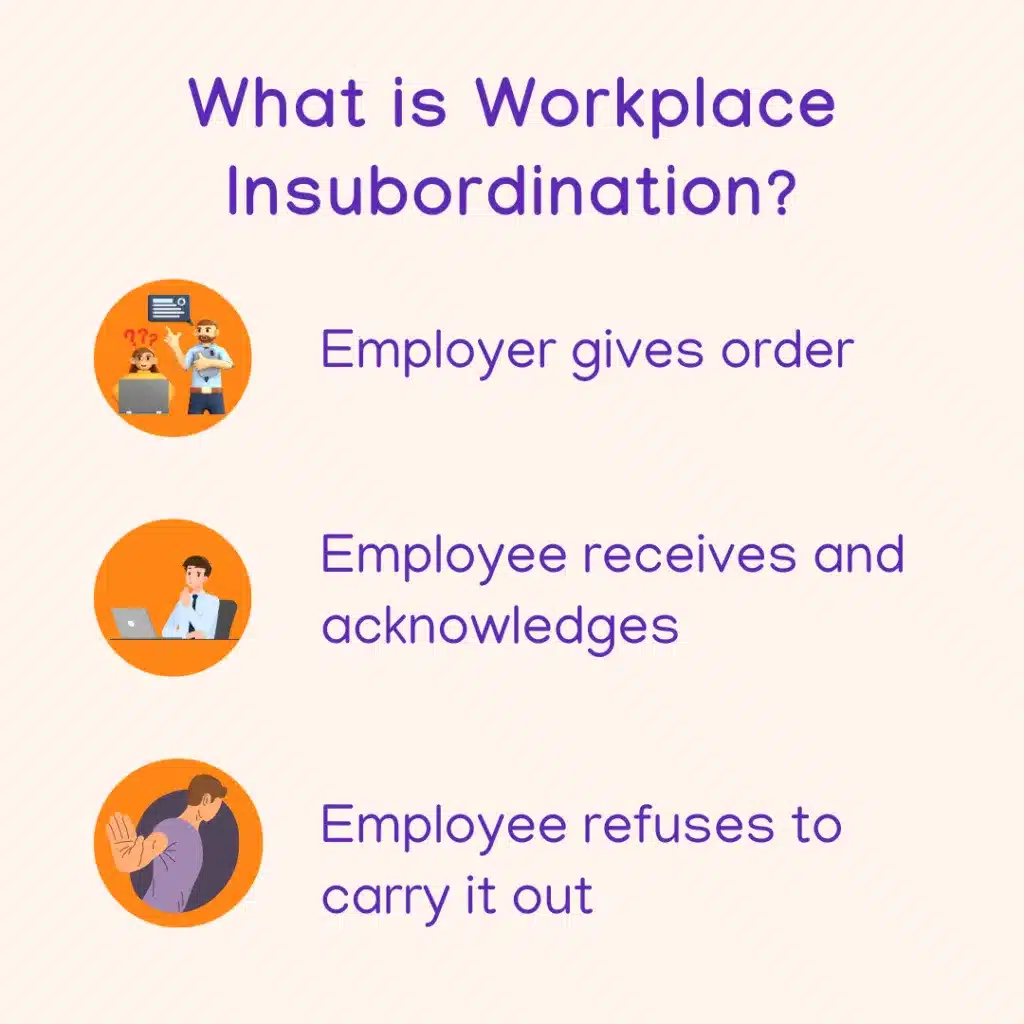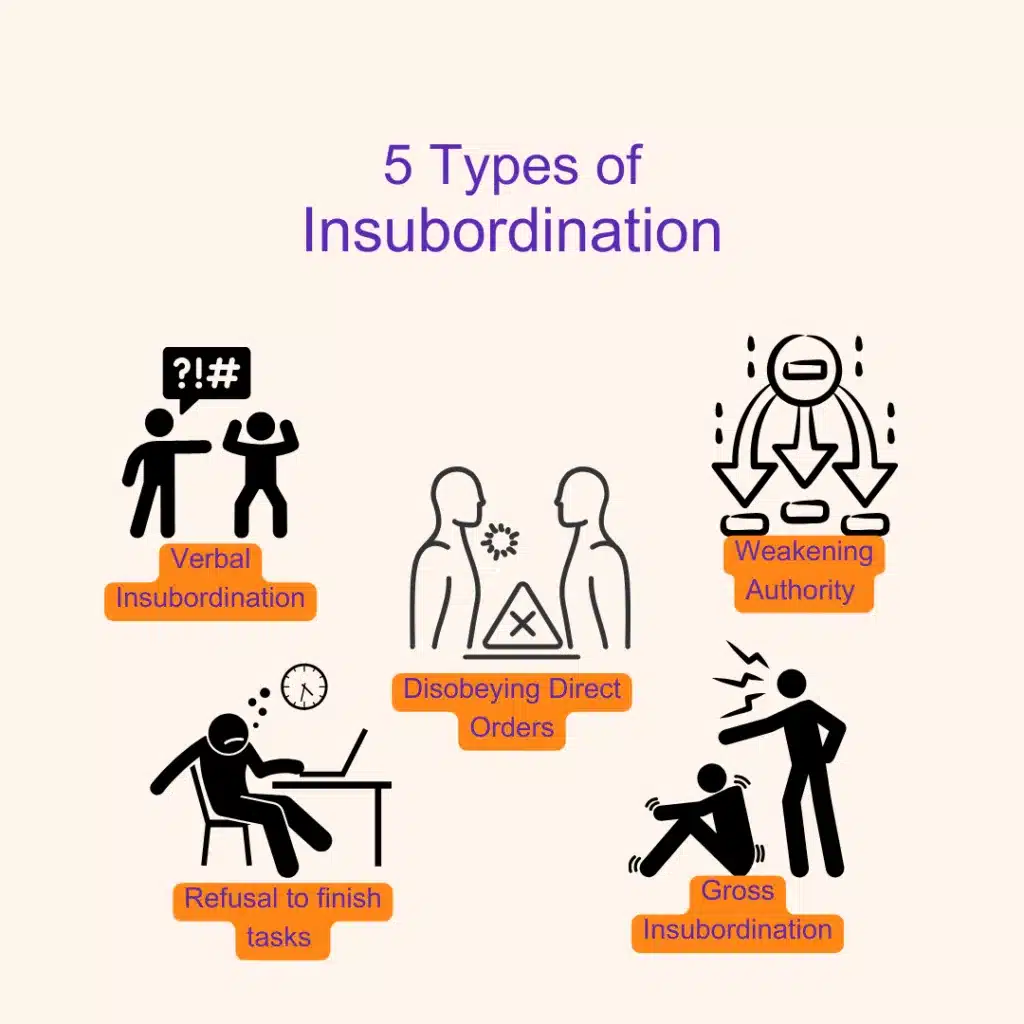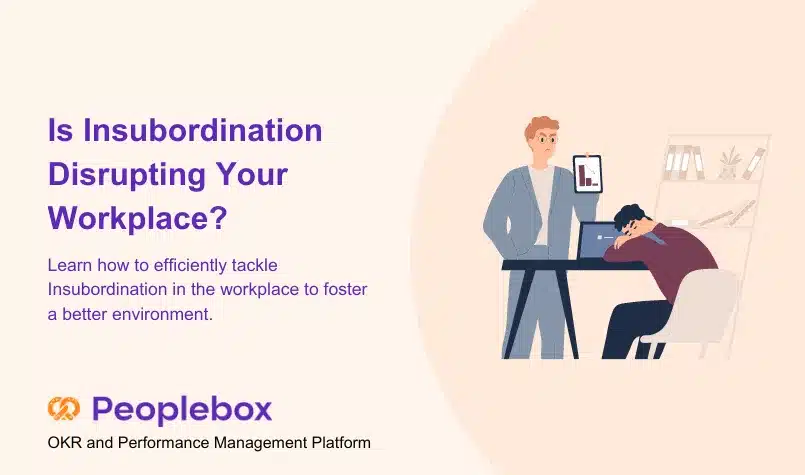In every modern workplace, conflicts are bound to arise; it’s inevitable. After all, each employee is different, with varying opinions and behaviors.
Managing these conflicts is part of the job. However, dealing with insubordination in the workplace is an entirely different concept.
What is insubordination at workplace? Define insubordination.
Insubordination at work refers to the refusal to obey orders or follow instructions from a superior.
It includes various forms of disrespect, such as defiance or refusal to complete tasks, and is considered insubordination when behaviors undermine authority, such as deliberately refusing to follow instructions, using disrespectful language, and publicly challenging a manager’s directives. This is considered a serious breach of workplace conduct.
In the modern workplace, where collaboration and cooperation are key to success, insubordination can greatly tamper with organizational harmony.
Insubordination at work not just creates conflicts but stagnates and compromises work while degrading its quality.
However, the consequences of insubordination are not limited to these. A decrease in the company’s productivity, an increase in workplace stress and lower morale are all likely to occur in the case of insubordination.
Individualism and creativity are greatly valued in today’s work environment, however, insubordination crosses the line from healthy disagreement into behavior that undermines authority.
When left unmanaged, insubordination can escalate into significant issues, posing challenges for both employers and managers.
This article delves into the nature of insubordination at work, exploring the different forms, causes, and impacts and providing practical strategies for managers to address and prevent insubordination.
What does insubordination at work entail?

According to the Society for Human Resources Management, insubordination at work officially occurs once these three factors take place
- An employer gives a lawful and reasonable order.
- The employee receives and acknowledges the order.
- The employee refuses to accept, follow, or carry out the order.
The direction can be verbal, written, or defined as part of an employee’s job description. It can be passed down from a supervisor to their direct reports, from the business owner or another authority figure.
The employee’s receipt of the direction does not require a formal acknowledgement; it can be as informal as being present in a meeting or reading an email containing the instruction.
What are the types of insubordination at the workplace?
Now that we’ve defined what insubordination means, let’s discuss a couple of examples to further understand:

1. Verbal insubordination
Verbal insubordination is using disrespectful language towards a manager.
Insubordination Examples:
- Flat-out refusal – An employee is asked to complete a task, and the employee responds with, “I’m not going to do it.”
- Offensive language – If an employee makes offensive comments about a supervisor such as insulting their gender, race or ethnicity.
- Insulting statements – When asked to finish a report, an employee says, “Sure, because we all know you can’t do it yourself.”
- Sarcasm and mockery – Responding to a supervisor’s request with a sarcastic tone.
- Abusive language – Communication that is disrespectful, threatening, or discriminatory, especially if used repeatedly or directed at colleagues or managers, falls under insubordination and can lead to disciplinary action.
2. Disobeying direct orders
Intentionally failing to follow instructions given by a supervisor is considered disobeying direct orders.
Insubordination Examples:
- Not completing tasks – An employee is instructed to finish inventory counts by the end of the day but instead spends the day on personal tasks.
- Violating company policies – Despite a clear no-smoking policy within the office, an employee is caught smoking in the building.
- Disregarding chain of command – An employee consistently bypasses their direct manager and goes straight to the CEO for minor issues.
- Employee refusing – An employee refusing to complete tasks assigned by their manager, illustrating a lack of cooperation and respect towards supervisors.
3. Weakening authority
This refers to behaviors that intentionally erode the power and effectiveness of a manager.
Insubordination Examples:
- Publicly humiliating – During a team meeting, an employee loudly disagrees with the manager’s strategy and mocks their competence.
- Ignoring instructions – A manager asks an employee to complete a client presentation, but the employee ignores the task and does not inform the manager.
- No communication – An employee withholds critical project updates, causing delays and confusion.
- Not cooperating – An employee consistently delays responses to a manager’s emails, hindering project progress.
- Insubordinate behavior – An employee intentionally undermines a manager’s authority by refusing to follow company directives or openly challenging their decisions.
4. Refusal to perform assigned tasks
This means deliberately declining to carry out duties or responsibilities that have been assigned by a supervisor.
Insubordination Examples:
- Passive resistance – An employee is asked to prepare a monthly report but drags their feet and delays it until the end of the month.
- Avoiding the task –An employee agrees to help with inventory but always finds excuses to be elsewhere when the time comes to do it. Note that this is different than when an employee does not have the resources to do the job, instead is when they choose not to do the task.
- Redirecting responsibilities – An employee constantly delegates their tasks to coworkers without proper authorization.
5. Gross insubordination
Gross insubordination involves severe and blatant acts of disobedience that show a complete disregard for authority, often leading to immediate disciplinary action, as far as termination
Insubordination Examples:
- Threats of violence – An employee threatens a supervisor with physical harm during a disagreement.
- Refusal to follow direct orders in front of others – An employee openly defies a direct order during a team meeting, undermining the manager’s authority.
- Sabotaging work or projects – An employee intentionally misplaces critical documents to delay project completion.
- Inciting organizational disruption – An employee encourages colleagues to protest management decisions by staging a walkout.
What are the Causes of Insubordination at Work?
1. Communication Challenges:
Instances of unclear instructions, misunderstandings of expectations, ineffective communication channels, language barriers, and misinterpretation of feedback can lead to confusion and frustration.
It is crucial to address insubordination through clear and effective communication to prevent such issues from escalating and disrupting the work environment.
2. Lack of Workplace Respect:
When employees do not feel respected or valued, especially by supervisors, it can foster resentment and negative attitudes towards authority.
Negative employee behavior can lead to insubordination, making it crucial to foster respect and understanding in the workplace.
3. Disagreement with Company Policies or Decisions:
Strong disagreements with specific policies or decisions may lead employees to refuse to comply with superiors, especially when these conflict with personal values.
4. Personal Issues and External Stress:
Stress stemming from personal issues such as family illness or financial difficulties can overwhelm individuals, impacting their behavior and potentially undermining authority as a coping mechanism.
Consequences of Insubordination at Workplace
1. Diminished Authority:
Each instance of unaddressed insubordination weakens managerial authority, leading to further challenges among employees.
2. Negative Impact on Employee Morale:
Witnessing or experiencing insubordination can lower employee morale and create tension, creating a negative workplace atmosphere. Moreover, it causes a rift between employees and managers.
3. Disruption to Workflow:
Insubordination disrupts normal operations, causing inefficiencies, delays, and heightened stress for other team members.
4. Reputational Damage:
Persistent insubordination issues can tarnish the organization’s reputation internally and externally, impacting client relationships and future recruitment efforts.
5. Legal and Financial Ramifications:
In extreme cases, such as insubordination cases of harassment or violence, organizations may face legal consequences and financial losses.
How to Deal With Insubordination at Workplace
(8-Step Action Plan)

Dealing with insubordination requires a mix of assertiveness, care and clarity. To deal with incidents of employee insubordination, HR leaders typically use this structured action plan:
Step 1: Documentation
As soon as the incident of insubordination occurs, document details immediately including the individuals involved, a description of the incident (date and time), and any witnesses.
The purpose of documentation is to ensure that a clear record of the event is maintained to take further action. It is crucial to maintain these detailed records in an employee file to support any future disciplinary actions and ensure a positive work environment.
Step 2: Assess the situation
Consider the degree of insubordination and assess any possible factors that may have contributed to the employee’s behavior, such as work stress, personal problems, etc.
This helps in providing context and determining the action to be taken.
Step 3: Have a Conversation with the Employee
Speak to the employee to understand their perspective. It is important to display sympathy throughout this process. Explain to the employee why their behavior was considered an act of insubordination, specifically highlighting that it was an employee’s refusal to comply with direct orders from management.
This is an opportunity for the employee to clarify company policies and express the importance of respecting authority.
Step 4: Identify Solutions
Discuss with the employee how they could improve by finding potential solutions. This could include training, meditation or reducing workload, depending on the cause of their behavior.
This ensures that the employee is aware that the organization aims to support them rather than reprimanding them
Establish Consequences: Verbal or Written Warnings
Discuss the consequences of insubordination, ranging from warnings to termination of employment.
This prepares the employee by setting expectations and consequences. It also ensures they understand the severity of the situation. If the insubordinate behavior persists, it may lead to further disciplinary action.
Step 6: Create an Action and Follow-Up Plan
Create an action plan, to give clarity on the steps to be taken next. It would also include steps the employee should take to improve their behavior. A follow up meeting should be scheduled to review progress.
It provides a clear framework for assessing improvements
Step 7: Provide Support and Resources
Offer counselling, training or meditation techniques to the employee to help them address any underlying issues to improve their ability to deal with workplace stress.
Providing these resources shows the company’s goal to foster a supportive environment for its employees.
Step 8: Review and Adjust
Review the effectiveness of the created action plan, while being prepared to make adjustments if necessary based on the employee’s progress.
This is done to ensure that the issue at hand is resolved wholly.
What is NOT Insubordination at work?
Now that I have shed light on how to deal with insubordination, it is also crucial to know what exactly insubordination is.
Insubordination at work is not the same thing as a poor attitude or assertiveness. Even questioning their employer’s actions and voicing their opinions are permissible to an extent.
When in doubt of what exactly insubordination entails, remember the two C’s-
Context and Communication
: Assess if the behavior is due to unclear instructions or legitimate grievances.
Communication: Engage in conversation to understand the employee’s perspective.
Preventing Insubordination at Work
1. Ensure there is Trust and Respect in the Workplace
Employers need to build a strong foundation of trust and respect with employees. They should be willing to explain their actions and be open to feedback and questions. Ensure employee engagement by recognizing and valuing employee contributions. A positive work environment can significantly reduce instances of insubordination by making employees feel valued and respected, which leads to improved morale and productivity in the workplace.
2. Be Fair
Employers cannot display any favoritism and should issue the same standard towards all employees. Unfair treatment will only foster resentment and could cascade into insubordination.
3. Communication is Key
A lack of communication can lead to several problems. To avoid confusion or misunderstandings, ensure that communication is sufficient amongst everyone in the organization. Clearly define acceptable behavior and consequences for insubordination. The employee handbook should outline workplace policies and procedures related to insubordination, ensuring employees understand expectations, reporting processes, and disciplinary actions.
4. Do not Ignore Signs
Employers should not let issues persist or ignore signs of insubordination. In case of defiance, employers should issue verbal or written warnings to convey the gravity of the situation. Issuing a verbal warning promptly is crucial as it directly communicates expectations and provides employees with an opportunity to correct their behavior before escalating to more serious disciplinary actions.
Understand Employee Laws and Employee Handbook
Employee actions are protected by law in some situations. Employees have the right to engage in activities such as discussing work conditions or asking for change without fear of punitive measures.
Becoming familiar with employee laws helps employers manage difficult relationships with professionalism.
Conclusion
Insubordination disrupts workplace harmony and productivity and by understanding its types, causes, and consequences employers can address it effectively. By implementing preventive measures, an eight-step action plan, clear policies, and open communication, managers can maintain this order and reduce the possibility of insubordination at work. Following these strategies ensures a positive, productive workplace where conflicts are minimized.








